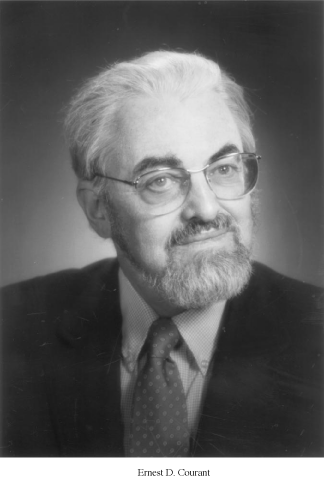Ernest Courant, Father of Modern Particle Accelerators, Receives 2007 UR Distinguished Scholar Award

Ernest Courant (UR Physics PhD 1943), emeritus distinguished scientist at Brookhaven National Laboratory and Adjunct Professor at the University of Michigan, has received the 2007 University of Rochester distinguished scholar award.
The distinguished scholar award recognizes graduate alumni who have gone on to distinguished careers in academia, industry, government, the arts, etc. An individual is eligible if he or she has a Ph.D. from the University. The Provost makes the final decision for this award, which is presented at the University doctoral commencement ceremony.
Prof. Courant is the fifth alumnus of the Department of Physics and Astronomy to receive a distinguished scholar award (see table below).
Ernest Courant has won many academic honors for his work, including the 1986 Enrico Fermi Award from the Department of Energy, "for his many contributions, for over three decades, to the physics of acceleration of charged particles; including his role in the invention of alternating gradient focusing which is the essential mechanism of strong focusing now used in accelerators of the highest energies; and for his many studies of beam interactions and instabilities that have been of critical importance in accelerator design."
Prof. Courant was also awarded the First Annual Robert R. Wilson Prize of the American Physical Society in 1987 and the Boris Pregel Prize of the New York Academy of Sciences in 1979. He is also a Member of the US National Academy of Sciences, NY (since 1976).
He was born in Germany in 1920 and came with his family to the United States in 1934. Courant's father was the famous mathematician Richard Courant. Courant became a naturalized US citizen in 1940. He graduated with a BA at Swarthmore College in 1940 and gained an MS in 1942 at The University of Rochester and a Ph.D in 1943 at the same university under the supervision of Victor Weisskopf. It was Weisskopf who advised Courant to join the Montreal project under his friend George Placzek. Courant spent 3 years, 1943-1946, working with Placzek, Volkoff and Wallace. It is worth noting that the paper on neutron density fluctuations in piles co-authored with P.R. Wallace is a classic and continues to be quoted to this day.
After the war, Courant went to Cornell as a "post-doc" working with Hans Bethe in nuclear physics, and in 1948, he joined the newly created Brookhaven National Laboratory to work on the beam dynamics of the Cosmotron (the world's first GeV accelerator). As a result of his work, Courant became one of the trio which originated the idea of "strong focusing" accelerators leading to the Brookhaven AGS, the CERN PS, and just about all the big accelerators since.
He retired in 1990 but still consults at Brookhaven, where he holds the position of Emeritus Distinguished Scientist. He was adjunct professor at SUNY Stony Brook (1966-1986) and currently holds the position of adjunct professor at the University of Michigan.
Prof. Courant's paper title ACCELERATORS, COLLIDERS, AND SNAKES, which was published in the Annual Review of Nuclear Science, traces his involvement in the evolution of particle accelerators over the past 50 years.
